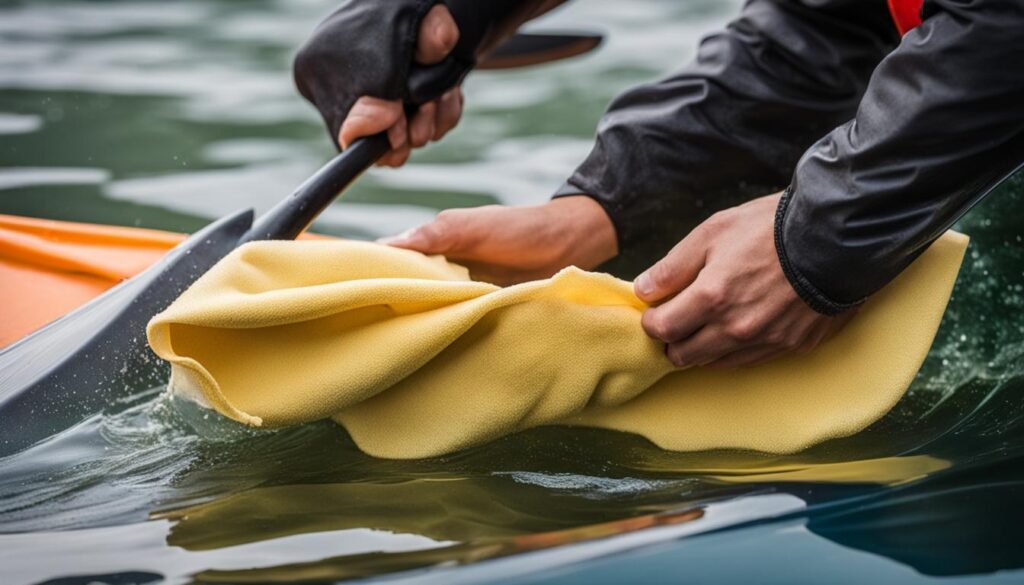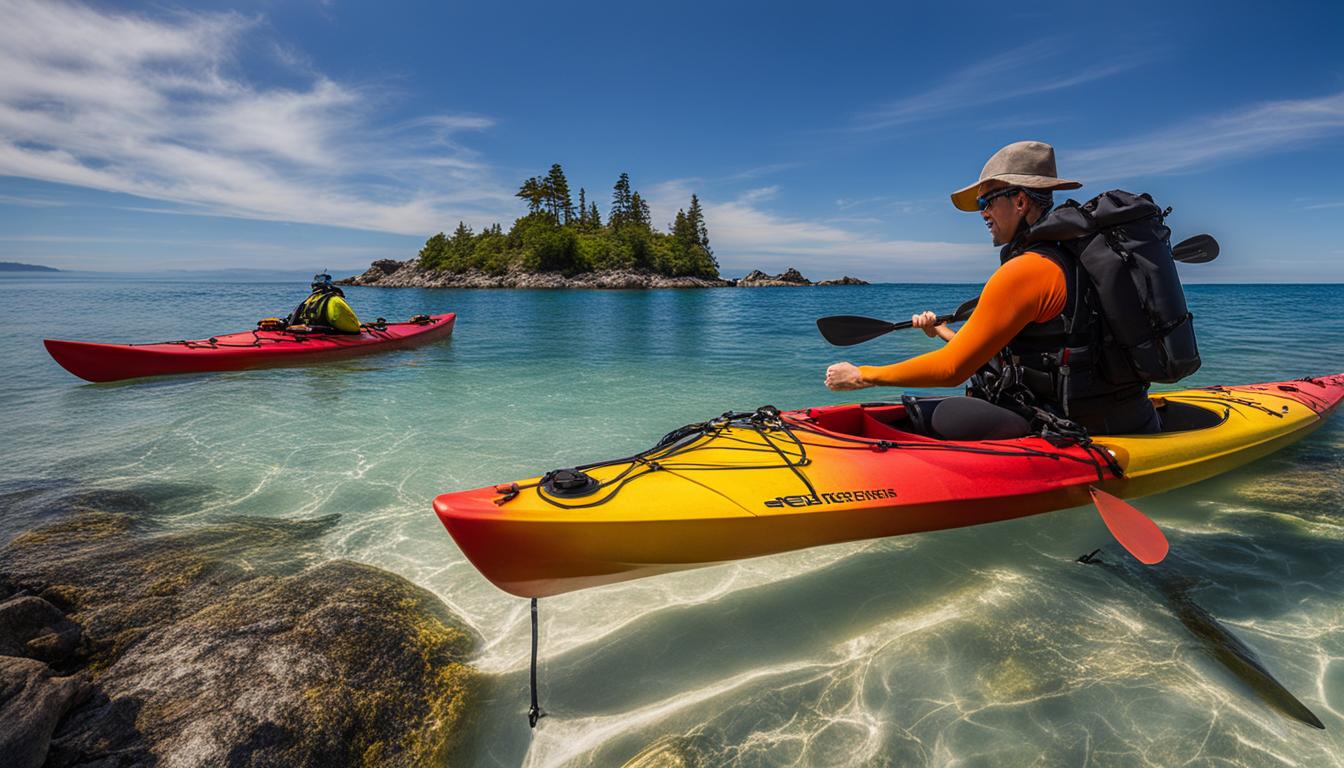Welcome to our guide on kayak maintenance and checks! Whether you own a kayak rental business or simply enjoy paddling in your free time, it’s essential to prioritize the quality and condition of your kayaks. Regular maintenance and thorough checks are crucial to ensure their longevity and the safety of anyone using them. In this article, we’ll cover everything you need to know about keeping your kayaks in top-notch condition. Let’s dive in!
Key Takeaways
- Kayak maintenance checks are vital for ensuring the longevity and safety of your kayaks.
- Regular inspections and repairs are especially important for kayak rentals, as they directly impact the customer experience.
- Prioritize spring maintenance to thoroughly inspect and prepare your kayaks before the paddling season starts.
- Cleaning your kayak after each use and applying UV protectant or wax will help keep it in good condition.
- Know how to repair small holes in inflatable kayaks to prevent further damage.
Preparing for the Season: Spring Maintenance
Before the start of the paddling season, it is crucial to thoroughly inspect and prepare your kayak. Regular maintenance is key to ensuring the quality and longevity of your rental kayaks. By performing routine checks and addressing any issues, you can provide a safe and enjoyable experience for your customers.
Start by examining the deck hardware, perimeter lines, and bungees for any signs of wear and tear. Look for loose or corroded fittings and replace them as needed. Pay special attention to kayaks that are frequently used in saltwater, as they require additional rinsing to prevent corrosion.
Next, evaluate the rudder or skeg system. Lubricate the moving parts and ensure that they are functioning properly. This is essential for kayaks that have these systems, as they play a significant role in maneuverability and control. Take the time to properly adjust and align the rudder or skeg to ensure optimal performance.
By addressing these maintenance tasks during the spring season, you can ensure that your rental kayaks are in optimal condition for your customers. Regular maintenance not only enhances the quality of your fleet but also reflects your commitment to providing a top-notch kayaking experience.
| Maintenance Tips for Spring |
|---|
| Thoroughly inspect deck hardware, perimeter lines, and bungees for wear and tear. |
| Rinse kayaks used in saltwater to prevent corrosion. |
| Check and lubricate the rudder or skeg system for proper functionality. |
Kayak Maintenance: Cleaning and Protecting Your Kayak
Regular cleaning is an essential part of maintaining the quality and longevity of your rental kayaks. After each use, make sure to rinse off any dirt, debris, or sunscreen that may have accumulated on the surface. This will prevent these substances from causing damage or discoloration over time.
To ensure a thorough cleaning, you can use a mild detergent or specialized kayak cleaner. Apply the cleaner to the kayak’s surface and use a soft brush or sponge to scrub away any stubborn stains or grime. Pay extra attention to areas such as the cockpit, deck, and hull where dirt can accumulate.
After cleaning, it is important to protect your kayak from the damaging effects of the sun’s UV rays. Exposure to prolonged sunlight can cause fading and weaken the kayak’s materials. To prevent this, apply a UV protectant or wax to the kayak’s surface. This will create a barrier that shields your kayak from the sun’s harmful rays.
Proper storage is also crucial for protecting your kayak when it is not in use. Find a safe and dry location to store your kayaks, away from direct sunlight and extreme temperatures. If possible, consider using a kayak cover to provide an extra layer of protection against dust, moisture, and debris.

Benefits of Regular Cleaning and Protection:
- Prevents damage to the kayak’s surface and materials
- Ensures a clean and enjoyable experience for customers renting your kayaks
- Prolongs the lifespan of your rental kayaks, reducing the need for frequent replacements
- Maintains the aesthetic appeal of your kayak fleet
- Protects against the harmful effects of UV rays, preventing fading and weakening of materials
By incorporating regular cleaning and protection into your kayak maintenance routine, you can uphold the quality standards of your kayak rentals and provide a positive experience for your customers.
Assessing Kayak Rental Fleet Condition
To ensure the quality and safety of your kayak rental fleet, it is essential to regularly assess the condition of the kayaks. By conducting thorough evaluations, you can identify any damages or issues that need to be addressed. Assessing the fleet condition not only helps maintain the integrity of the kayaks but also ensures the satisfaction of your customers.
Table: Kayak Rental Fleet Condition Assessment Checklist
| Aspect | Assessment Criteria |
|---|---|
| Hull | Check for cracks, scratches, or deformations |
| Deck Hardware | Inspect fasteners, handles, and fittings for looseness or damage |
| Perimeter Lines and Bungees | Ensure they are intact and securely attached |
| Rudder or Skeg System | Test functionality and lubricate moving parts |
| Seat and Footrests | Check for signs of wear and tear, ensure proper adjustment |
| Overall Cleanliness | Inspect for dirt, grime, and mildew |
Regularly conducting these assessments allows you to proactively address any repair or maintenance needs. It is important to regularly follow up with necessary repairs and replacements to keep your kayak rental fleet in optimal condition.
Additional Tips for Kayak Maintenance
Proper maintenance is key to ensuring the longevity and performance of your kayak rental fleet. In addition to the regular maintenance tasks outlined in previous sections, here are some additional tips to keep in mind:
- Clean your kayak regularly: Before and after each use, rinse off any dirt, saltwater, or debris that may have accumulated on your kayak. Use a mild detergent or specialized kayak cleaner to remove stubborn stains and grime. Regular cleaning helps prevent the build-up of dirt and extends the lifespan of your kayak.
- Apply UV protectant: To shield your kayak from the harmful effects of the sun’s UV rays, apply a UV protectant or wax. This helps prevent fading, cracking, and other damage caused by prolonged sun exposure. Be sure to follow the manufacturer’s instructions for application.
- Inspect the hull: Regularly inspect the hull of your kayaks for any signs of damage, such as cracks or distortions. Address any issues promptly to prevent further damage. This is especially important for rental kayaks, as they are often subjected to more wear and tear.
- Use a kayak cart: When transporting your kayak, always use a kayak cart. This helps avoid unnecessary strain on the kayak and makes it easier to move from one location to another. Avoid dragging or carrying your kayak for long distances, as this can cause damage to the hull and other components.
- Cover the cockpit: When your kayak is not in use, cover the cockpit with a cockpit cover. This helps protect the interior of the kayak from debris, leaves, and other unwanted elements. It also prevents animals from making nests inside the cockpit.
- Check and replace worn-out parts: Regularly inspect your kayak rental fleet for any worn-out parts or hardware. This includes handles, hatches, bungees, and seating. Replace any damaged or worn-out components to ensure the safety and functionality of the kayaks.

Maintaining a Top-Quality Kayak Rental Fleet
By following these maintenance procedures and tips, you can ensure that your kayak rental fleet remains in excellent condition. Regular cleaning, applying UV protectant, inspecting the hull, using a kayak cart, covering the cockpit, and checking for worn-out parts are all essential steps in maintaining the quality of your kayaks.
Remember to assess the condition of your rental fleet frequently and address any repairs or maintenance needs promptly. This will not only enhance the customer experience but also prolong the lifespan of your kayaks, ensuring a profitable and successful kayak rental business.
| Maintenance Task | Frequency | Importance |
|---|---|---|
| Cleaning | After each use | High |
| UV Protectant Application | Every few weeks | High |
| Hull Inspection | Monthly | Medium |
| Using a Kayak Cart | Every time you transport the kayak | Medium |
| Covering the Cockpit | When the kayak is not in use | Medium |
| Checking and Replacing Worn-out Parts | Regularly | High |
Proper Storage Practices
Proper storage is essential for maintaining the quality and condition of your kayak rental fleet. By implementing good storage practices, you can protect your kayaks from damage caused by prolonged exposure to UV rays and extreme weather conditions. Here are some maintenance procedures for rental kayaks and tips for optimal storage:
Indoor Storage
If possible, store your kayaks indoors to provide maximum protection. Indoor storage helps shield the kayaks from the harmful effects of UV rays, which can cause fading and deterioration over time. It also protects the kayaks from extreme temperatures, preventing potential damage to the hull and other components. Ensure that the storage area is well-ventilated and free from excessive moisture to avoid any potential mold or mildew growth.
Proper Kayak Positioning
When storing your kayaks, it is important to position them correctly to avoid any deformations or stress on the hull. Use storage racks or slings that support the weight of the kayak evenly to distribute the load. Avoid storing the kayak on its side for an extended period, as this can cause structural problems and misalignment. If you need to stack the kayaks, use proper padding or foam blocks to protect the hull and prevent any damage.
Regular Inspection
Regularly inspect the storage area for any signs of moisture or potential vermin infestation. Moisture can lead to mold growth and damage the kayaks, so it is crucial to address any leaks or dampness promptly. Take measures to control humidity levels and ensure adequate ventilation. Additionally, keep an eye out for any signs of pests and take appropriate actions to prevent them from causing damage to your kayak rental fleet.
Summary
Proper storage practices are integral to maintaining the quality and longevity of your kayak rental fleet. Storing your kayaks indoors, positioning them correctly, and conducting regular inspections will help prevent damage caused by UV exposure, extreme weather conditions, and pests. By implementing these maintenance procedures for rental kayaks and following these tips, you can ensure that your kayaks are always in optimal condition for your customers to enjoy.
Maintenance Procedures for Rental Kayaks: Gel-coat Repairs for Composite Kayaks
Composite kayaks, with their sleek design and superior performance, are a popular choice for kayak rentals. However, over time, these kayaks may experience scratches or structural damages to their gel-coat layer. While minor scratches can be considered cosmetic and add character to the kayak, deep scratches or exposed fiberglass cloth should be repaired promptly to prevent further damage.
To address these issues, gel-coat repairs are often necessary for composite kayaks. Gel-coat, a protective layer on the exterior of the kayak, can be applied as a repair solution for minor cosmetic issues. Simply sand the damaged area, apply the gel-coat with a brush or roller, and allow it to cure. Once the gel-coat is fully cured, sand the repaired area to match the surrounding surface. This process helps restore the kayak’s appearance and protects it from further wear and tear.
For more extensive repairs involving structural damages or large areas of exposed fiberglass cloth, fiberglass cloth and epoxy resin are required. This method involves applying layers of fiberglass cloth and epoxy resin to reinforce the damaged area. The cloth is saturated with epoxy resin, applied to the damaged section, and smoothed out to ensure proper adhesion. After curing, excess cloth and resin can be sanded down to create a seamless finish. This repair technique restores the kayak’s strength and integrity, ensuring it can withstand the demands of rental use.
Table: Gel-coat Repair Materials for Composite Kayaks
| Materials | Usage |
|---|---|
| Gel-coat | Repair minor cosmetic scratches |
| Sandpaper (various grits) | Prepare the damaged area for repair |
| Brush or roller | Apply gel-coat evenly |
| Epoxy resin | Repair structural damages and reinforce fiberglass cloth |
| Fiberglass cloth | Provide structural support |
| Scissors or utility knife | Cut fiberglass cloth to size |
| Squeegee or roller | Smooth out fiberglass cloth and resin |
| Sandpaper (various grits) | Finish the repair, matching the surrounding surface |
By incorporating gel-coat repairs into your kayak maintenance procedures, you can ensure the longevity and quality of your rental fleet. Regularly assess the condition of your kayaks, identify any damages, and address them promptly. This proactive approach not only enhances the customer experience but also protects your investment in the rental business.
Remember, a well-maintained kayak fleet not only attracts customers but also builds a reputation for reliability and professionalism. So, make gel-coat repairs an integral part of your maintenance routine, ensuring that your composite kayaks remain in excellent condition for years to come.
Conclusion
Proper maintenance procedures are essential for ensuring the longevity and quality of your rental kayaks. By regularly assessing the condition of your kayak rental fleet, you can identify any damages or wear and tear that require attention. Implementing a thorough maintenance routine, including cleaning, repairs, and storage practices, will help keep your kayaks in top-notch condition.
By following the tips and procedures outlined in this article, you can ensure that your rental kayaks are always ready for your customers to enjoy. Regular checks and inspections will help you address any issues promptly, preventing further damage and ensuring the safety of your customers. Cleaning your kayaks after each use and using UV protectants will help preserve their appearance and protect them from the harmful effects of the sun.
Remember to regularly inspect and replace any worn-out parts or hardware to maintain the performance and functionality of your kayaks. By implementing good storage practices, you can protect your kayaks from extreme weather conditions and prolong their lifespan. By prioritizing maintenance and assessing the condition of your kayak rental fleet, you can provide a positive customer experience and ensure the continued success of your business.
FAQ
Why is proper maintenance important for kayaks?
Proper maintenance is important for kayaks to ensure their longevity and safety. Regular checks and inspections help identify issues and make necessary repairs, ensuring the kayaks are in optimal condition for rental use.
What should I check before the start of the paddling season?
Before the start of the paddling season, thoroughly inspect and prepare your kayak. Check the deck hardware, perimeter lines, bungees, rudder or skeg system, and ensure their proper functionality.
How should I clean my kayak after each use?
Rinse off any dirt, debris, or sunscreen that may have accumulated after each use. Use a mild detergent or specialized kayak cleaner to remove stubborn stains and grime. Apply a UV protectant or wax to prevent fading and damage from the sun.
How can I repair small holes in inflatable kayaks?
For temporary fixes, you can use duct tape or repair tape. For a more permanent solution, consider using glue or patches specifically designed for inflatable kayaks.
What additional tips should I keep in mind for kayak maintenance?
Keep your kayak clean, inspect the hull for damage, use a kayak cart when transporting, cover the cockpit when not in use, regularly check and replace worn-out parts or hardware, and store your kayak in a safe location.
What are proper storage practices for kayaks?
Store your kayak indoors if possible, use storage racks or slings that support the kayak’s weight evenly, inspect the storage area regularly for moisture or vermin, and avoid storing the kayak on its side to prevent deformation.
How can I repair gel-coat scratches or structural damages in composite kayaks?
For minor scratches, gel-coat can be used as a cosmetic fix. For deep scratches or exposed fiberglass cloth, fiberglass cloth and epoxy resin are required for more extensive repairs.





